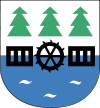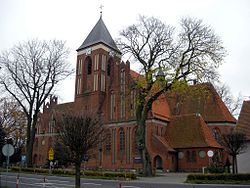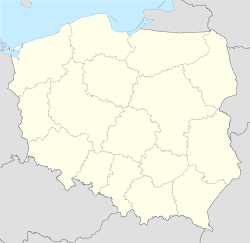- Czersk
-
For other places with the same name, see Czersk (disambiguation).
Czersk Saint Mary Magdalene Church 
Flag
Coat of armsCoordinates: 53°47′34″N 17°58′26″E / 53.79278°N 17.97389°E Country  Poland
PolandVoivodeship Pomeranian County Chojnice Gmina Czersk Established 13th century Town rights 1386-1772, 1926 Government - Mayor Marek Jankowski Area - Total 9.73 km2 (3.8 sq mi) Population (2006) - Total 9,463 - Density 972.6/km2 (2,518.9/sq mi) Time zone CET (UTC+1) - Summer (DST) CEST (UTC+2) Postal code 89-650 Area code(s) +48 52 Car plates GCH Website www.czersk.pl Czersk [t͡ʂɛrsk] is a town in northern Poland in Chojnice County, Pomeranian Voivodeship.
On July 1, 2006 this municipality celebrated 80 years of granting this community (July 1, 1926) the status of city.
Today the centrum of City of Czersk in downtown is the Village Square. The infrastructure was recently modernized, rebuilt roadway system, modern center of commerce, 400 seats sport hall, water and wastewater treatment systems, railroad station.
The historical treasure is Neo-baroque-style parish church. The oldest described and documented church is from the year of 1584. The recent church was erected between 1910-1913 based on the project of F.O. Hossfed. The local industries include timber processing mills, brick factory, paper plant, woving plant, furniture, metallurgy and factory of agricultural equipment, brewery, large trout farm, and food processing. The craft and commerce are flourishing.
History
The most significant historical dates of City of Czersk:
- 13th century – The establishment of the parish community including Rytel, Łąg, Mokre, Malachin.
- 1309 - The oldest historical evidence supports the fact the growth of the settlement after Teutonic Knights have overtaken the Pomeranian Gdańsk and establishing the Tuchola community. At that time Czersk was a country site with operating mill, inn, bitumic trade and bees farms.
- 1330 – The first historical acknowledgment of Czersk community.
- 1584 – Publication about first and the oldest known description of the Czersk church;
- 1772–1902 – Partitions of Poland and Annexation to Prussia;
- 1827 – The first carriages are crossing Czersk the horse carriage tract between Berlin and Königsberg;
- 1873 – Opening of Eastern Railroad Berlin – Königsberg; first major commercial economical development;
- 1887 – Startup of Herman Shütta enterprise – presently Czersk Furniture Factory KLOSE; The beginning of history of furniture manufacturing in Czersk;
- 1913 – Completion of construction of still existing Czersk Church;
- 1914–1918 – First World War; Through the prisoner camp located around Łukow passed about 50,000 war prisoners mainly Russian;
- January 29, 1920 – With victorious entry of General Józef Haller de Hallenburg Blue Army armed forces, Czersk return to Poland after Partitions of Poland and Prussian annexation and domination;
- July 1, 1926 r. – Czersk receive from the than Polish Government the City rights;
- September 1, 1939–February 21, 1945 – Second World War with the period of Nazi occupation (harassment, killing, executions and murders of citizens of Czersk and surrounding terrains, murders of the elite, political and administrative personnel). Establishment of armed partisan formation, undercover operation of very poorly armed resistance groups;
- February 21, 1945 – Entry of Red Army to Czersk, end of Hitler's Nazi occupation;
- May 27, 1990 – First after II World War alleged democratic election with self-determination of Czersk community;
- 1994–2002 – Construction of new center of commerce around J.Ostrowski street;
- January 19, 2001 – Completion of 400 seats Sport's arena Hall named after R. Bruski;
- Starting from 1990 – Systematic development of modern infrastructure (potable water system, sewer system and wastewater treatment plants (Czersk and Rytel), heating gas distribution, development of modern road system, modernisation of railroad);
Links
Coordinates: 53°47′N 17°58′E / 53.783°N 17.967°E
References
Town and seat Czersk
Villages Badzianko • Bagna • Będźmierowice • Bielawy • Błoto • Brda • Budziska • Bukowa Góra • Cegielnia • Czerska Struga • Dąbki • Duża Klonia • Duże Wędoły • Gartki • Gotelp • Gutowiec • Jeziórko • Kaliska • Kameron • Kamionka • Karolewo • Kęsza • Klaskawa • Kłodnia • Klonowice • Konewki • Konigort • Konigórtek • Koślinka • Kosowa Niwa • Koszary • Krzyż • Kurcze • Kurkowo • Kwieki • Łąg • Łąg-Kolonia • Lipki • Listewka • Łubna • Łukowo • Lutom • Lutomski Most • Mała Klonia • Malachin • Małe Wędoły • Młynki • Modrzejewo • Mokre • Mosna • Nieżurawa • Nowa Juńcza • Nowe Prusy • Nowy Młyn • Odry • Olszyny • Ostrowite • Ostrowy • Płecno • Pod Łąg • Pod Łubnę • Polana • Przyjaźnia • Pustki • Rówki • Rytel • Rytel-Zarzecze • Sienica • Stara Juńcza • Stare Prusy • Stodółki • Struga • Suszek • Szałamaje • Szary Kierz • Szyszkowiec • Twarożnica • Uboga • Uroża • Ustronie • Wądoły-Łąg • Wandowo • Wędowo • Wieck • Wojtal • Zapędowo • Zapora • Zawada • Złe Mięso • Złotowo • ŻukowoCategories:- Cities and towns in Pomeranian Voivodeship
- Chojnice County
Wikimedia Foundation. 2010.


